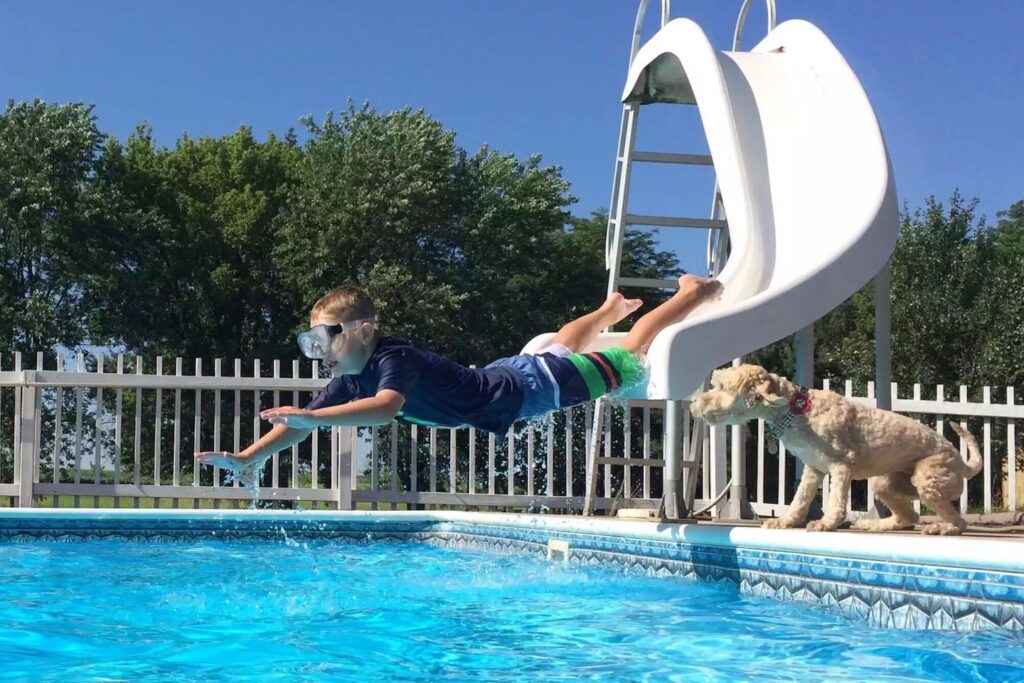Swimming Safety for Dogs


It might surprise you to learn that not all dogs are born knowing how to “doggy paddle.” In fact, some dogs hate the water and some are just terrible swimmers. Dwayne “The Rock” Johnson learned this the hard way when his new puppy sank like a rock in his pool (don’t worry! Dwayne, living up to his action star status, immediately saved the pup!). The best way to avoid this scenario is to familiarize yourself with proper dog swimming safety. Make sure you take proper precautions, and you and your pooch can happily enjoy the water together. And if your dog hates swimming? Don’t force it. Maybe a baby pool is more their style.
Always Supervise
Supervision is incredibly important. Just like you would with a human child, always supervise your fur-kid when they go for a swim. Some dog breeds are better swimmers than others, but all of them need their owner keeping a close watch. Whether your pooch is splashing around in a pool or pond or on the beach, make sure your dog never enters the water without you present. This is even important for experienced canine swimmers. You never know when a riptide or other surprise might occur.
When you arrive at your swimming destination, check out the area. Ask yourself these questions:
- Do you know where the exits are?
- Do you know how deep the water is?
- Are you familiar with how strong the tide or current is?
- Are there underwater hazards like sharp rocks or coral?
- Are there potentially toxic contents in the water, such as pond scum?
- If you’re not going in the water with your dog, are you perched somewhere you can quickly and easily dive in?
Outfit Your Pool
If you’re a pool owner, there are a few ways you can make your pool area a little safer — for dogs and cats who might fall in. After all, cat owners need to practice good water safety as well. First you can fence in your pool. Keep the gate locked and your dog outside the pool area when you’re not able to watch them play. This way you can make sure your dog doesn’t have access to the water when they’re playing outdoors.
You can even equip your pool with an alarm that sounds when the water’s surface is broken. This will alert you if your sneaky dog manages to get past the fence and go for a dip! Lastly, provide your dog with a way to easily exit your pool. A ramp will do the trick.
Prepare for the First Swim
Before that first session in the water, purchase a life jacket for your dog. It needs to fit properly — life jackets are NOT “one size fits all.” The jacket must be sized for your dog’ size and weight. And opt for one that is intended for water with currents.
It’s important that all dogs know “stay” and “come,” but mastering those commands is even more crucial when your pup is around a body of water. You can also carry toys and treats around as backup tools to lure your dog out of the water or keep them from diving in. Attend one of a new adopters training class if you’re interested in learning more about training your pooch! It’s also a good idea to learn pet CPR and first aid.
Introduce Slowly
Take things gradually when you first take your dog swimming. Start small — try letting them explore the water in a shallow bathtub or fenced-in pool. This way you’ll be there to quickly scoop them out of the water if your pup has difficulty staying afloat. If your dog really seems to be struggling, wrap your arm around their belly while they practice paddling.
Take the Lead
Some dogs may not naturally know how to swim or exit the body of water. In cases like these, take the lead! Show your dogs where to get out of the water, whether that be swimming toward the shore or climbing out of your pool via stairs.
Keep It Short
Know when to call it a day. All that exercise can tire out your dog and a wiped out pooch is more susceptible to drowning. Make sure you have drinking water on hand as your pet is also likely very thirsty.



